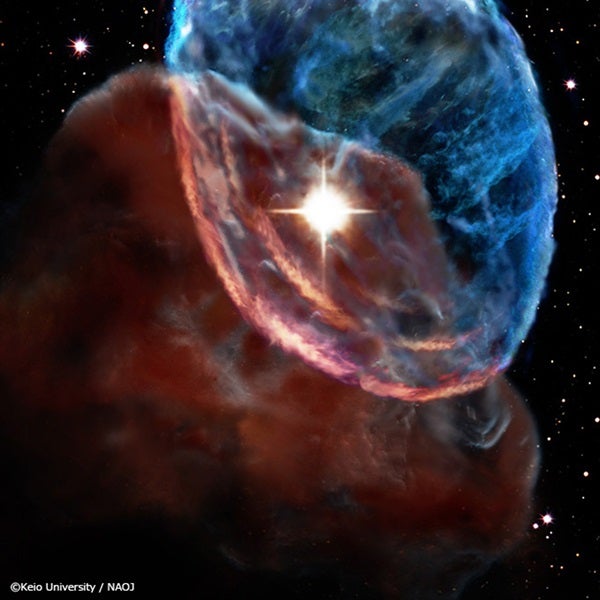The analysis shows that the expansion velocity of the W44 shock wave is 8.0 ± 0.1 miles per second (12.9 ± 0.2 km). In addition, it became clear that the supernova explosion released kinetic energy of 1–3 x 10^50 erg into the interstellar medium. The energy emitted from the Sun is approximately 3.6 x 10^33 erg/s. Can you image how enormous amount of energy is released from the supernova explosion? Furthermore, other molecular gas with an extremely high velocity of higher than 100 km/s was also detected. The origin of this super-high-velocity molecular gas remains unclear at the present time.
A star with a mass of more than eight times that of the Sun releases tremendous energy when it is dying and undergoes a supernova explosion. The shock wave caused by the supernova explosion expands, having a strong impact on the composition and physical state of surrounding interstellar materials. It also emits kinetic energy into interstellar space. “Galactic winds” blasting out a large amount of gas are often observed in galaxies where explosively active star formation takes place. The energy source of such galactic wind is also thought to be many supernova explosions.
Thus, supernova explosions have an immense influence on interstellar space. Nevertheless, there has been no quantitative research on the expansion velocity and kinetic energy of a supernova shock wave. This is because a wide area must be observed in order to study the expansion velocity and kinetic energy of a supernova shock wave. Wide-area observations with the existing equipment require long observation times. Therefore, observations of interstellar gas influenced by a supernova shock wave have been limited to a narrow area.
The research team started its observations mainly with radio telescopes in the late 1990s. The purpose is to study interaction of the supernova remnant W44 and the adjacent giant molecular cloud (GMC). W44 is a roughly 6,500- to 25,000-year-old supernova remnant. Attached to the remnant is a GMC with a mass of approximately 300,000 times the mass of the Sun. Since observations began, molecular spectrum lines with a wide velocity width have been detected in the W44 molecular cloud in various places. They have been interpreted to be gas that has been accelerated by the passage of the supernova shock wave.
The research team used the 45-meter telescope at Nobeyama Radio Observatory (NRO), National Astronomical Observatory of Japan (NAOJ), and the 10-meter Atacama Submillimeter Telescope Experiment (ASTE) to make high-sensitivity video imaging observations of the full area of W44.
The observations revealed that spectrum lines with a wide velocity width were detected throughout the whole area where W44 overlapped the GMC. The research team calculated velocity centroids from these spectrum lines and examined their spatial distribution. From the distribution, a clear velocity gradient was found from the center to the edge of W44. This can be thought of as the expansion activity of shocked gas, or molecular gas affected by a shock wave.
In addition, the observations detected a molecular gas component with an extremely high velocity. These positions of super-high-velocity molecular gas are the exact locations where the sources of continuum radiation and a molecular hydrogen oscillation emission line are also detected. This indicates that strong shock waves existed locally. The origin of the super-high-velocity component remains a mystery at the present time.
The research team plans to plow ahead to uncover the nature of the mysterious component. Furthermore, the team will observe a larger number of shocked gases surrounding the supernovae to confront these observational results with theoretical models of a supernova shock wave.










